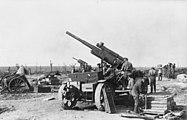8.8 cm Flak 16
In this article, we will delve into the fascinating world of 8.8 cm Flak 16 and explore its many facets. From its impact on society to its possible implications in the future, 8.8 cm Flak 16 has captured the attention of experts and fans alike. Through an exhaustive and considered analysis, we will seek to shed light on this relevant and, at the same time, so enigmatic topic. Join us on this journey of discovery and reflection, where we will unravel the secrets and wonders that 8.8 cm Flak 16 has to offer us.
| 8.8 cm Flak 16 | |
|---|---|
 8.8 cm Flak 16 cannon | |
| Type | Anti-aircraft gun |
| Place of origin | German Empire |
| Service history | |
| In service | 1917-1918 |
| Used by | German Empire |
| Wars | World War I |
| Production history | |
| Designer | Krupp |
| Designed | 1916 |
| Manufacturer | Krupp |
| No. built | 169 |
| Variants | Flak 17, 18 |
| Specifications | |
| Mass | Transport: 7,300 kg (16,100 lb) Combat: 3,100 kg (6,800 lb) |
| Barrel length | 3.9 m (12 ft 10 in) L/45 |
| Shell | Fixed QF |
| Shell weight | 9.4 kg (20 lb 12 oz) |
| Caliber | 88 mm (3.46 in) |
| Breech | Horizontal sliding-block |
| Recoil | Hydro-pneumatic |
| Carriage | Four-wheeled cruciform outriggers |
| Elevation | -4° to +70° |
| Traverse | 360° |
| Rate of fire | 10 rpm |
| Muzzle velocity | 785 m/s (2,575 ft/s) |
| Maximum firing range | Horizontal: 10.8 km (6.7 mi) Vertical: 6,850 m (22,470 ft) |
The 8.8 cm Flak 16 was a German 8.8 cm anti-aircraft gun from World War I, forerunner of the 8,8 cm FlaK/PaK Flak 18/36/37 of World War II. Its contemporary name was the 8,8 cm K.Zugflak L/45.
Development
Designs for dedicated anti-aircraft guns existed before World War I, but few were in service by the outbreak of war. Early anti-aircraft artillery guns used in World War I were primarily adaptations of existing medium-caliber weapons, mounted to enable fire at higher angles. By 1915, the German military command realized that these were useless for anything beyond deterrence, even against vulnerable balloons and slow-moving aircraft. With the increase of aircraft performance, many armies developed dedicated AA guns with a high muzzle velocity – allowing the projectiles to reach greater altitudes. The first such German gun, the Flak 16, was introduced in 1917, using the 88 mm caliber, common in the Kaiserliche Marine.
Design
The barrel for the 8.8 cm K.Zugflak L/45 was built from steel and was 45 calibers in length. The gun had a semi-automatic Krupp horizontal sliding-wedge breech to boost its rate of fire. There was a hydro-pneumatic recoil system located above and below the barrel, along with an equilibriator to balance the gun. The gun was capable of 360° of traverse and -4° to +70° of elevation.
See also
Photo Gallery
References
- ^ a b c Fleischer, Wolfgang (February 2015). German Artillery:1914-1918. Barnsley. p. 94. ISBN 9781473823983. OCLC 893163385.
{{cite book}}: CS1 maint: location missing publisher (link) - ^ a b Westermann, Edward B. (2005–2009) . Flak: German Anti-aircraft Defenses 1914-1945. Modern War Studies. University Press of Kansas. pp. 19, 36–38, 44, 53, 58, 83, 90, 108, 128–129. ISBN 9780700614202.


